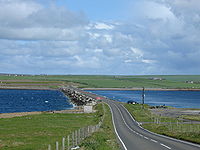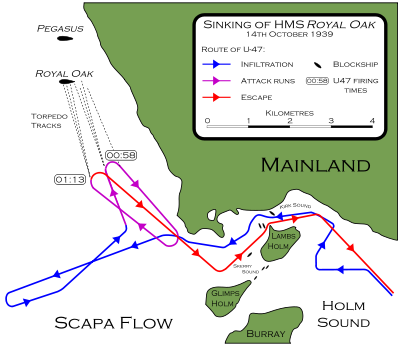
Churchill Barriers
Encyclopedia

Causeway
In modern usage, a causeway is a road or railway elevated, usually across a broad body of water or wetland.- Etymology :When first used, the word appeared in a form such as “causey way” making clear its derivation from the earlier form “causey”. This word seems to have come from the same source by...
s in the Orkney Islands
Orkney Islands
Orkney also known as the Orkney Islands , is an archipelago in northern Scotland, situated north of the coast of Caithness...
, Scotland
Scotland
Scotland is a country that is part of the United Kingdom. Occupying the northern third of the island of Great Britain, it shares a border with England to the south and is bounded by the North Sea to the east, the Atlantic Ocean to the north and west, and the North Channel and Irish Sea to the...
, with a total length of 1.5 miles (2.3km). They link the Orkney Mainland in the north to the island of South Ronaldsay
South Ronaldsay
South Ronaldsay is one of the Orkney Islands off the north coast of Scotland. It is linked to the Orkney Mainland by the Churchill Barriers, running via Burray, Glimps Holm and Lamb Holm.-Geography and geology:...
via Burray
Burray
Burray is one of the Orkney Islands in Scotland. It lies to the east of Scapa Flow and is one of a chain of islands linked by the Churchill Barriers.-Geography and geology:...
and the two smaller islands of Lamb Holm
Lamb Holm
Lamb Holm is a small uninhabited island in Orkney, Scotland. The remarkable Italian Chapel, constructed during the Second World War, is the island's main attraction.-Geography:...
and Glimps Holm.
The barriers were built in the 1940s primarily as naval defences to protect the anchorage at Scapa Flow
Scapa Flow
right|thumb|Scapa Flow viewed from its eastern endScapa Flow is a body of water in the Orkney Islands, Scotland, United Kingdom, sheltered by the islands of Mainland, Graemsay, Burray, South Ronaldsay and Hoy. It is about...
, but now serve as road links, carrying the A961 road
A961 road
The A961 is a single-carriageway road on the eastern side of Scapa Flow in the Orkney Islands, connecting the town of Kirkwall on the Orkney Mainland to Burwick at the southern end of South Ronaldsay....
from Kirkwall
Kirkwall
Kirkwall is the biggest town and capital of Orkney, off the coast of northern mainland Scotland. The town is first mentioned in Orkneyinga saga in the year 1046 when it is recorded as the residence of Rögnvald Brusason the Earl of Orkney, who was killed by his uncle Thorfinn the Mighty...
to Burwick.
History

Scapa Flow
right|thumb|Scapa Flow viewed from its eastern endScapa Flow is a body of water in the Orkney Islands, Scotland, United Kingdom, sheltered by the islands of Mainland, Graemsay, Burray, South Ronaldsay and Hoy. It is about...
in a nighttime attack by the German
Kriegsmarine
The Kriegsmarine was the name of the German Navy during the Nazi regime . It superseded the Kaiserliche Marine of World War I and the post-war Reichsmarine. The Kriegsmarine was one of three official branches of the Wehrmacht, the unified armed forces of Nazi Germany.The Kriegsmarine grew rapidly...
U-boat
U-boat
U-boat is the anglicized version of the German word U-Boot , itself an abbreviation of Unterseeboot , and refers to military submarines operated by Germany, particularly in World War I and World War II...
U-47 under the command of Günther Prien
Günther Prien
Lieutenant Commander Günther Prien was one of the outstanding German U-boat aces of the first part of the Second World War, and the first U-boat commander to win the Knight's Cross of the Iron Cross. Under Prien's command, the submarine sank over 30 Allied ships totaling about...
. Shortly before midnight on the 13 October the U-47 had entered Scapa Flow through Kirk Sound between Lamb Holm
Lamb Holm
Lamb Holm is a small uninhabited island in Orkney, Scotland. The remarkable Italian Chapel, constructed during the Second World War, is the island's main attraction.-Geography:...
and the Orkney Mainland
The Mainland, Orkney
The Mainland is the main island of Orkney, Scotland. Both of Orkney's burghs, Kirkwall and Stromness, lie on the island, which is also the heart of Orkney's ferry and air connections....
. Although the shallow eastern passages had been secured with measures including sunken block ships, booms and anti-submarine net
Anti-submarine net
An anti-submarine net is a device placed across the mouth of a harbour or a strait for protection against submarines.-Examples of anti-submarine nets:*Lake Macquarie anti-submarine boom*Indicator net*Naval operations in the Dardanelles Campaign...
s, Prien was able to navigate the U-47 around the obstructions at high tide. He then launched a surprise torpedo attack on the unsuspecting Royal Navy battleship while it was at anchor in Scapa Flow. The U-47 then escaped seaward using the same channel by navigating between the block ships.
In response, First Lord of the Admiralty Winston Churchill
Winston Churchill
Sir Winston Leonard Spencer-Churchill, was a predominantly Conservative British politician and statesman known for his leadership of the United Kingdom during the Second World War. He is widely regarded as one of the greatest wartime leaders of the century and served as Prime Minister twice...
ordered the construction of several permanent barriers to prevent any further attacks. Work began in May 1940 and was completed by September 1944. However the barriers were not officially opened until 12 May 1945, four days after the end of World War II in Europe.
Construction
The contract for building the barriers was awarded to Balfour BeattyBalfour Beatty
Balfour Beatty plc is a British construction, engineering, military housing, rail and investment services company. It is one of the largest construction companies in the UK, and the 15th largest in the world...
, although part of the southernmost barrier (between Burray and South Ronaldsay) was sub-contracted to William Tawse & Co. The first Resident Superintending Civil Engineer was E K Adamson, succeeded in 1942 by G Gordon Nicol.
Preparatory work on the site began in May 1940, while experiments on models for the design were undertaken at Whitworth Engineering Laboratories at the University of Manchester
University of Manchester
The University of Manchester is a public research university located in Manchester, United Kingdom. It is a "red brick" university and a member of the Russell Group of research-intensive British universities and the N8 Group...
.
The bases of the barriers were built from gabion
Gabion
Gabions are cages, cylinders, or boxes filled with soil or sand that are used in civil engineering, road building, and military applications. For erosion control caged riprap is used. For dams or foundation construction, cylindrical metal structures are used...
s enclosing 250,000 tons of broken rock, from quarries on Orkney. The gabions were dropped into place from overhead cableways into waters up to 59 feet deep. The bases were then covered with 66,000 locally-cast concrete blocks in five-tonne and ten-tonne sizes. The five-ton blocks were laid on the core, and the ten-tonne blocks were arranged on the sides in a random pattern to act as wave-breaks.
Labour
A project of this size required a substantial labour force, which peaked in 1943 at over 2,000.Much of the labour was provided by over 1300 Italian prisoners of war whom had been captured in the desert war
North African campaign
During the Second World War, the North African Campaign took place in North Africa from 10 June 1940 to 13 May 1943. It included campaigns fought in the Libyan and Egyptian deserts and in Morocco and Algeria and Tunisia .The campaign was fought between the Allies and Axis powers, many of whom had...
in North Africa, and were transported to Orkney from early 1942 onwards. As the use of POW labour for War Effort works is prohibited under the Geneva Conventions
Geneva Conventions
The Geneva Conventions comprise four treaties, and three additional protocols, that establish the standards of international law for the humanitarian treatment of the victims of war...
, the works were justified as 'improvements to communications' to the southern Orkney Islands
The prisoners were accommodated in three camps, 600 at Camp 60 on Little Holm and the remaining 700 at two camps on Burray. Those at Camp 60 built the ornate Italian Chapel
Italian Chapel
The Italian Chapel is a highly ornate Catholic chapel on Lamb Holm in Orkney, Scotland. It was built by Italian prisoners of war during World War II, who were housed on the previously uninhabited island while they constructed the Churchill Barriers to the east of Scapa Flow. Only the concrete...
which still survives and has become a tourist attraction.

